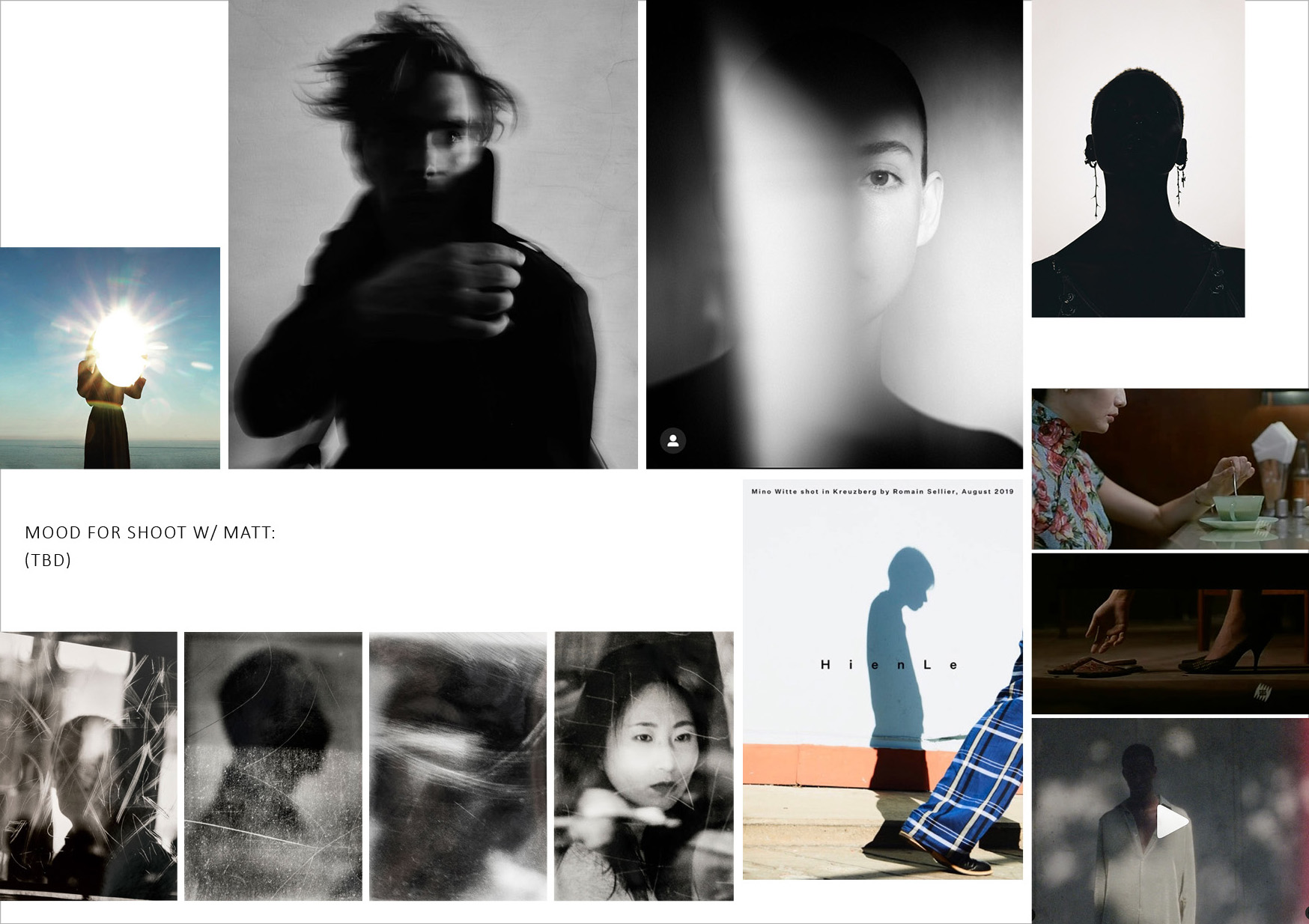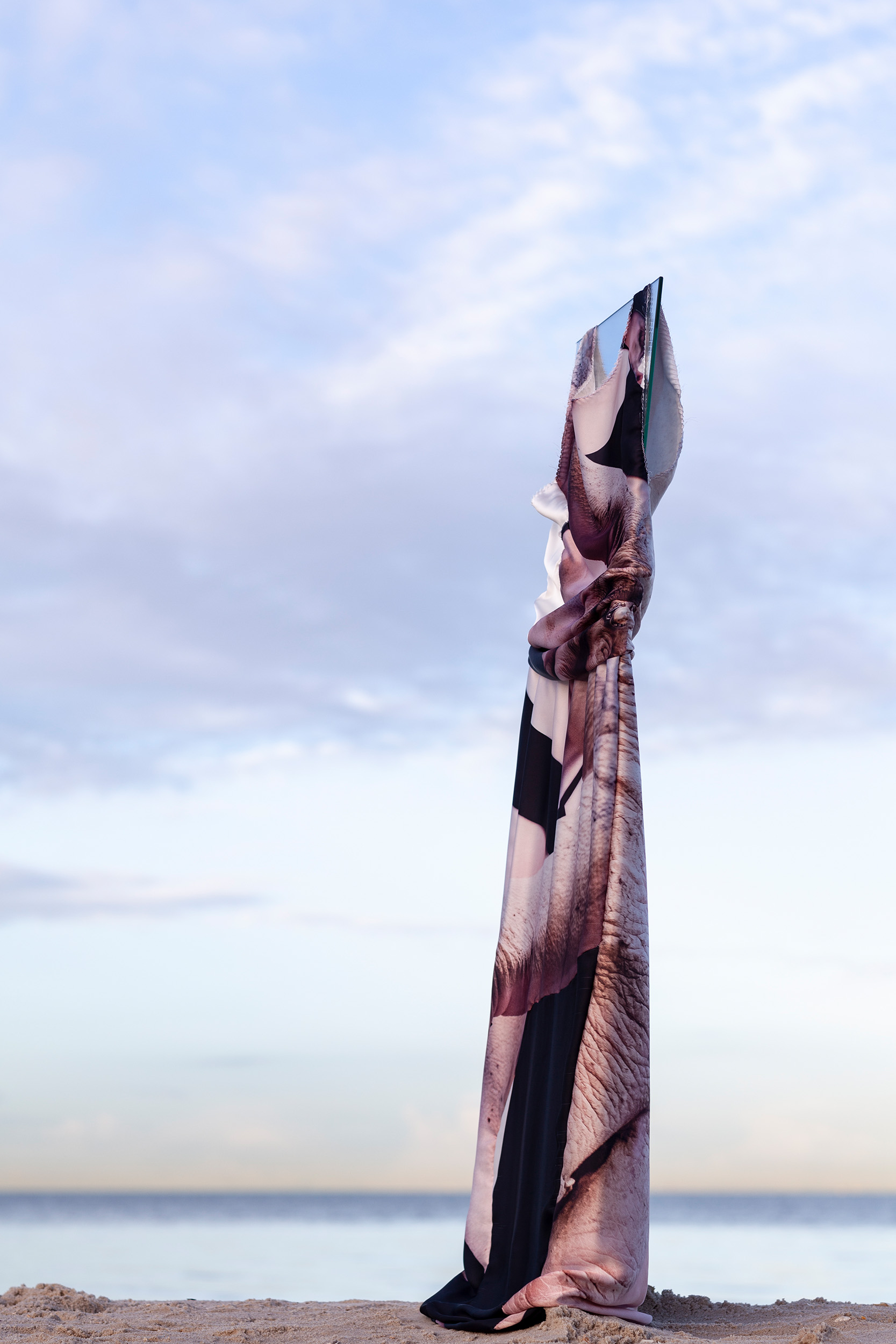WEEK 8: SUPERVISOR SESSION (W/ SHANE)
D O C U M E N T S T R U C T U R E P L A N
The pink parts definitely still need work but also all the rest is only so-so.
Q U E S T I O N S
- »This project seeks to explore the complexity of personality and individuality through photography and fashion.« or only photography (without fashion)?
- Objectives are optional … really?
- Not sure about the Rationale, if it's that good.
- Not sure what I contribute to the community of practice.
- No idea what my Research Question is.
- Is the process described in the Methodology too detailed?
- Description of Heuristic Methodology too detailed?
- Do the pictures on a moodboard have to be referenced individually?
- Themes for Creative Practice as Appendix?

Example for moodboard: If I include it as a visual, do I have to reference each image?
F E E D B A C K
- »This project seeks to explore the complexity of personality and individuality through photography and fashion.« or only photography (without fashion)?
»This photographic project seeks to explore the complexity of personality and individuality (informed by fashion).« or in other parts »informed by fashion as a concept«
- Objectives are optional … really?
OK. What are you hoping to achieve? But leave them out if you don't want to add them.
- Not sure about the Rationale, if it's that good.
The rationale is a very succinct attempt at explaining why the project is important and why it's going to contribute to our understanding of something. Maybe it's as simple as »the project is located within a field of inquiry that includes photography, portraiture, and fashion, and as such it responds to some of the concepts and codes and conventions that exist within fashion photography. For example, these photographers …«. The key part of a rationale is »this is the field of inquiry the project is located in, who is informing the project and what they have done and their contribution to that field; here is what I'm doing that's different.«
Rather than naming names the way I do now, start with their context, field, and exploration (field of inquiry) is and then identifying similar themes that link with each of those. For example, within the theoretical positioning of the “photographic self” (knowing of being photographed the subject presents another self > part of the challenging authentic nature of photographic imagery: an image is only authentic if a person does not know that they are photographed). You align with that as a concept because you are presenting the photographic self. And then you can draw from that Barthes similar commentary about the self and other theorists. Lindbergh as a fashion photographer: instead of starting with him, what is it what he did that was of interest?
Maybe the fashion industry is a means to which to construct and visualize the inquiries. But maybe the inquiries themselves are more about the authentic self? How do you challenge notions of the authentic self or photographic self in photographic portraiture? You came up with a complex methodology of identifying something that is important to someone, photographing them, turning that into clothing, and eventually making someone else wear these clothes. As a way of interrogating the difference between the nature of clothing and how someone wants to be seen photographically.
What is the project about? Personality, individuality etc., or the photographic self and authenticity? I think it's the first part but I don't like saying it as it makes me sound very cheesy and that I have found the solution to world peace etc. But I don't have to say those things. That's the power of a rationale: Where you locate the concept of the project in a field of inquiry that is not just (fashion) photography but more aligned with the conceptual contextualization of the project. Without an assessment judgment, or talking up. Only locate it. And then it becomes part of a conversation that is quite specific around the notion of an inquiry. You don't have to sell/pitch it. You just say where it lives, that it's in this build of inquiry. And this is why it's there, and who else informed it. The value of putting it into a field of inquiry is it enables to draw out the concepts aligned with the community of practice, demonstrates who informed it, and the nature of the inquiry. And that ultimately you have conducted a research project (creatively and conceptually).
But also, the document structure plan in table form seems to throw me off.
- Not sure what I contribute to the community of practice.
Just locate it. You don't have to contribute.
- No idea what my Research Question is.
My projects don't feel like research. So, how would I have a research question? Research = looking for something. Search and search again. Looking for ways of doing something. Research does not have to be high-level engagement in something. What you are doing: Working out a way of making images about something. (Different from responding to an interest.) How do I make the images better? Looking at other people's work. Re-shooting. One step further: And contextualizing the nature of what the research has been. So that you can align that with the language of research.
Here is the concept. Here is the field of inquiry (I'm locating it within here, here are some of the other people who work in that space, and some of the ideas, theories, concepts that come out of that, and this is how I'm responding to that). This is the methodology I'm going to do.
- Is the process described in the Methodology too detailed?
- Description of Heuristic Methodology too detailed?
- Do the pictures on a moodboard have to be referenced individually?
Yes. Show more moodboards.
- Themes for Creative Practice as Appendix?
S T U D I O P R O J E C T : M A T T
F E E D B A C K
My problem right now is that these images don't feel like fashion photography but more like portrait photography. It's not a huge issue and I never wanted to make a conventional fashion photography project, but maybe now I'm a bit off. I want to position it in fashion photography, but not as typical fashion photography.
Solution: We don't have to think about fashion as a genre of photography. You can simply position it as an influence within the project. And so, shifting away from it being a fashion photoshoot. Which it never was anyway. It can be informed by fashion, equally as informed by portraiture or cinematography. But you can conceptually anchor into the codes, conventions, theories, and context of fashion photography without it being a fashion photography project.
Nice photos but they don't fit into the selected series.
I N S T A L L A T I O N I D E A S
I have 4 options right now:
- Printing on matte paper, bringing the series closer together again.
- Printing on fabric for the movement. Strategically it would be good to do this as it is different. But I do not really see a reason for it. I'd lose detail (which again means I could print bigger).
- Printed posters in a sleeve sent to the assessors (potentially incl. printed report – if finished early enough).
- Online.
Themes for Contemporary Practice: Figuration, Representation and Virtuality.
Shoot #2: Clothes fit and suit Karen.
I still have to make a selection. I just want to use one picture.
»I feel that these are not my clothes.«
F E E D B A C K
Bottom right: Shane tends to this one. The neckline is powerful. She looks like she's more in the image. The composition has more structure to it. And still feels disconnected.
But it does depend on what I want. In the other images she looks discombobulated and uncomfortable.
Color images are better than black and white.
Shoot #3: Clothes do not fit or suit Michelle.
I still have to make a selection. I just want to use one picture. The pictures were made with three different cameras: DSLR, disposable analog, and SLR.
»I would walk around in this.«
F E E D B A C K
Harder to choose. Agrees that bottom left is good. Image structure is good. Not bottom right. The others don't reveal much.
Shoot #1: Clothes are not worn by a person.
I still have to edit the final photograph.
»…«

F E E D B A C K
Dress only needs lifting (brightness) by 5%. Sand is not neutral and has a magenta cast, therefore neutralize it a bit but not too much as it has the early morning light. Also, white areas of the dress are probably not actually white (slightly red maybe).
Would look great in life-size.





































